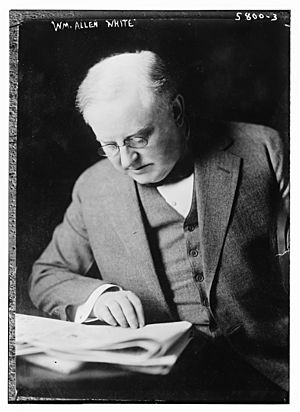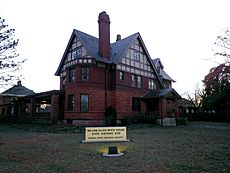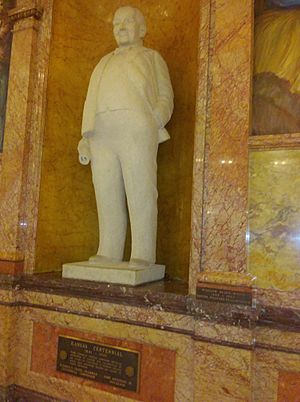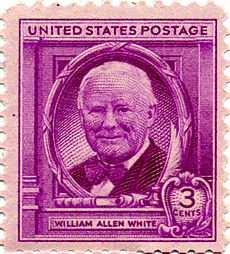William Allen White facts for kids
Quick facts for kids
William Allen White
|
|
|---|---|
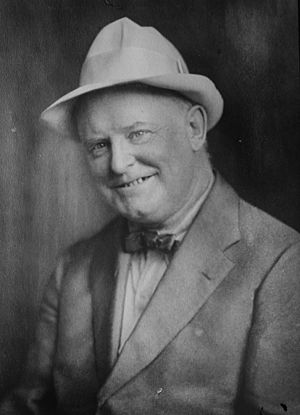 |
|
| Born | February 10, 1868 Emporia, Kansas, United States
|
| Died | January 29, 1944 (aged 75) Emporia, Kansas
|
| Education | College of Emporia University of Kansas |
| Occupation | Newspaper editor, author |
| Spouse(s) | Sallie Lindsay |
| Children | 2, including William |
| Parent(s) | Allen, Mary Ann |
| Signature | |
William Allen White (February 10, 1868 – January 29, 1944) was an important American newspaper editor, writer, and political leader. He was a key figure in the Progressive movement, which aimed to improve society. From 1896 until his death, White became a voice for people living in the middle of America.
Many people admired him. In 1937, the Kansas Editorial Association called him "the most loved and most distinguished member" of the Kansas press.
Contents
Early Life and Education
William Allen White was born in Emporia, Kansas. He later moved to El Dorado, Kansas with his parents, Allen and Mary Ann Hatten White. He spent most of his childhood there. Young William loved animals and enjoyed reading books.
He studied at the College of Emporia and the University of Kansas. In 1889, he started his career as a writer for The Kansas City Star newspaper.
The Emporia Gazette Newspaper
In 1895, White bought a newspaper called the Emporia Gazette for $3,000. He became its editor and made it very famous.
"What's the Matter with Kansas?" Editorial
Early in his career, White held conservative political views. In 1896, he wrote an editorial called "What's the Matter With Kansas?" This article became nationally famous.
In the editorial, White strongly criticized the Democrats and the Populists. He argued that their policies were hurting Kansas's economy. He believed their anti-business ideas scared away money and jobs.
The Republican Party printed and shared hundreds of thousands of copies of this editorial. They used it to support William McKinley in the 1896 United States presidential election. This made William Allen White well-known across the country.
White was known for his good humor and clear writing. His Gazette articles were often reprinted in other newspapers. He also wrote stories about politics and published many books. His most famous writings were "What's the Matter With Kansas?" and "Mary White." The latter was a loving tribute to his 16-year-old daughter after she died in 1921.
In 1923, he won a 1923 Pulitzer Prize for his editorial "To an Anxious Friend." He wrote this after being arrested for speaking out about free speech. This happened during a dispute over how Kansas handled workers involved in the Great Railroad Strike of 1922.
His Ideas About Small Towns
In his stories and books, White often wrote about small towns. He saw them as a way to understand how society changes. He believed small towns showed the importance of community. Even though he wrote about small towns, his ideas appealed to people in growing cities too.
He was against chain stores and mail order companies. He thought they threatened local businesses on "Main Street." The Great Depression made him question his belief in a cooperative America. He had mixed feelings about the New Deal, President Franklin D. Roosevelt's plan to help the country. White thought Roosevelt cared, but his solutions seemed unplanned. By 1940, White saw the country coming together against foreign threats.
Fighting for Good Government
White wanted to encourage a strong moral order in the nation. He knew there were powerful forces of corruption. But he believed in slow, helpful changes that came from the middle class. In his book In the Heart of a Fool (1918), he wrote that reforms protected property rights.
He felt that the Spanish–American War brought political unity. He also believed that a moral victory would make up for the damage of World War I. White thought that democracy after World War I lacked direction. The New Deal left him feeling confused. Still, he held onto his vision of a cooperative society until he passed away in 1944.
His Political Life
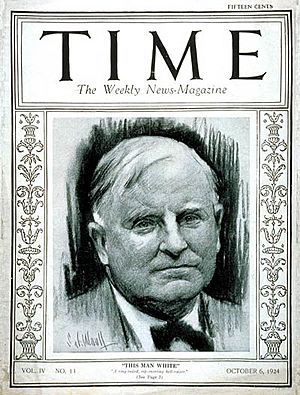
William Allen White became a leader of the Progressive movement in Kansas. In 1912, he helped create the Kansas Republican League to oppose powerful railroad companies. He also helped Theodore Roosevelt start the Progressive (Bull-Moose) Party. This was during the 1912 United States presidential election. They opposed the more traditional Republican president, William Howard Taft.
White was a reporter at the Paris Peace Conference in 1919. He strongly supported Woodrow Wilson's idea for the League of Nations. The League started, but the U.S. never joined. In the 1920s, White criticized the Republican Party for being too isolated and conservative.
One of White's most important actions was fighting against the Ku Klux Klan. Starting in 1921, he wrote strong editorials in the Gazette against them. To spread his message even wider, he decided to run for governor of Kansas in 1924. He didn't win the election, but many believed his efforts helped weaken the Klan in Kansas.
In the 1930s, he supported Republican presidential candidates like Alf Landon in 1936 and Wendell Willkie in 1940. However, White was on the more liberal side of the Republican Party. He wrote many articles praising President Franklin D. Roosevelt's New Deal programs.
Supporting Artist John Steuart Curry
White played a big role in getting Kansas newspaper editors to raise money. Their goal was to invite John Steuart Curry, a famous Kansas artist, to paint murals for Kansas. White got support from Governor Walter Huxman and other politicians. This led to Curry being invited to paint murals for the Kansas Capitol. One of his famous works there is Tragic Prelude.
The "Sage of Emporia"
For the last 25 years of his life, White was seen as a national spokesperson for Middle America. Because of this, President Franklin Roosevelt asked White to help gain public support for the Allies before America joined World War II. In 1940, White was key in forming the Committee to Defend America by Aiding the Allies.
He continued to write articles for the Gazette until he died in 1944. He was also a founding editor of the Book of the Month Club.
His Family Life
William Allen White married Sallie Lindsay in 1893. They had two children: William Lindsay, born in 1900, and Mary Katherine, born in 1904. Sadly, Mary died in a horse-riding accident in 1921. Her father wrote a famous tribute to her called "Mary White" on May 17, 1921.
White traveled a lot, visiting six of the seven continents. Because of his fame, he received 10 honorary degrees from universities, including one from Harvard.
White taught his son, William L., the importance of journalism. After White's death, William L. took over the Gazette and kept it successful. After William L. died, his wife Kathrine ran the paper. Today, the Emporia Gazette is still run by the family. William Allen White's great-grandson, Christopher White Walker, is currently in charge.
Friendships with Presidents Roosevelt
White became good friends with President Theodore Roosevelt in the 1890s. This friendship lasted until Roosevelt's death in 1919. Theodore Roosevelt even stayed at White's home, Red Rocks, during his trips across the United States. White once said, "Roosevelt bit me and I went mad," meaning Roosevelt inspired him greatly. Later, White supported many parts of the New Deal, but he voted against Franklin D. Roosevelt in every election.
Famous Visitors to Red Rocks
Many famous people visited the White family home, Red Rocks, in Emporia:
- Theodore Roosevelt
- Herbert Hoover
- Calvin Coolidge
- Edna Ferber
- Henry J. Allen
- Frances Louise Tracy and Anne Morgan (wife and daughter of J.P. Morgan)
- Douglas Fairbanks
- Dorothy Canfield
His Death
William Allen White died on January 29, 1944, in Emporia. He had just finished a chapter in his autobiography about his daughter Mary's death. His son, William Lindsay, completed his father’s autobiography. This book later won a Pulitzer Prize.
Honors After His Death
Life magazine described White as "the small-town boy who made good at home." They said he showed that small-town life could be great. He was a symbol of small-town simplicity and common sense.
During World War II, the city of Emporia raised $25,000 in war bonds. This allowed them to name a B-29 bomber after their most famous citizen, William Allen White. This bomber was part of the same squadron as the Enola Gay. Also, a Liberty ship named William Allen White was launched in 1944.
His autobiography, published in 1946, won the 1947 Pulitzer Prize for Biography or Autobiography. In 1948, the U.S. Postal Service issued a 3¢ stamp in his honor.
The University of Kansas Journalism School is named after him. So is the library building at Emporia State University. The William Allen White Foundation also created two awards: The William Allen White Award for excellent journalism and the Children's Book Award.
Today, Emporia still honors him with signs on I-35, US-50, and K-99 that say "Home of William Allen White."
Images for kids
See also
- Theodore Roosevelt
- Progressive Party (United States, 1912)
- William Lindsay White
- Emporia Gazette
- Pulitzer Prize
- Great Railroad Strike of 1922
- William Allen White Cabins, the Whites' summer retreat, now in Rocky Mountain National Park and listed in the National Register of Historic Places


